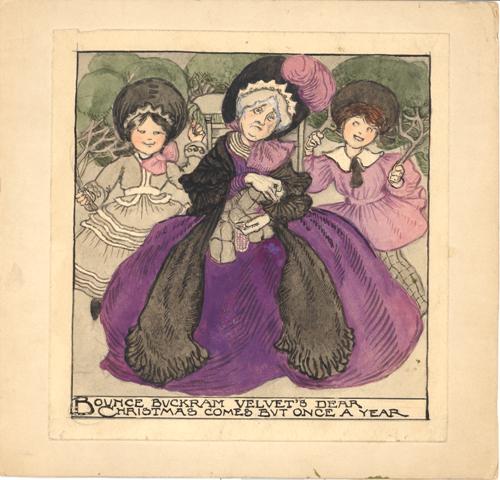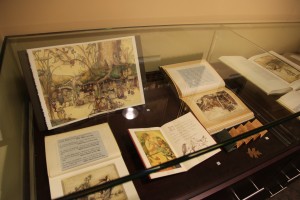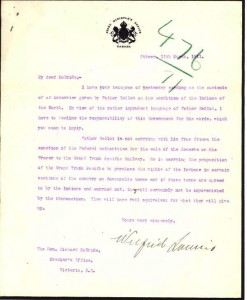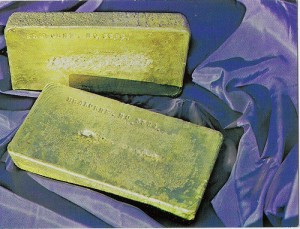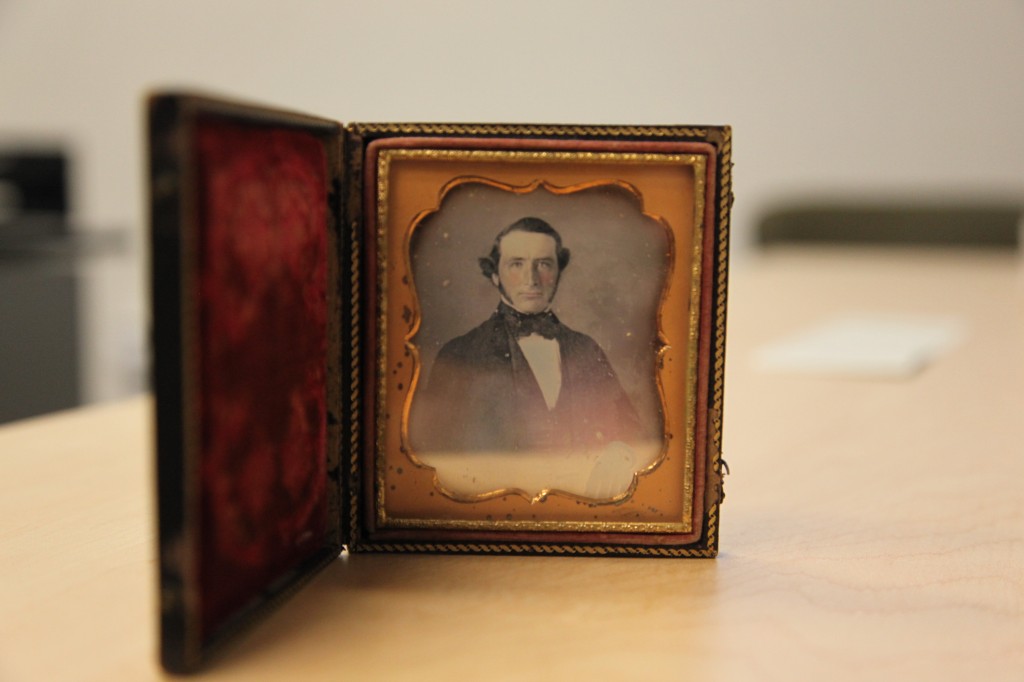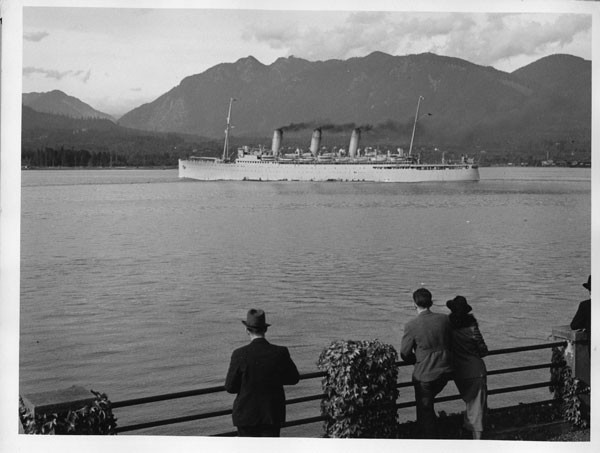Chung Collection room closure
Posted on January 18, 2012 @10:56 am by sromkey
The Chung Collection exhibition room will be closed on Monday January 23. We apologize for the inconvenience. This closure also effects the “75 Years of Controversy: Canada’s Governor General’s Literary Awards” exhibition. Both exhibitions will re-open on Tuesday Jan. 24.
Cross-posted with the Chung Collection News blog.
No CommentsPosted in Announcements, Exhibitions, Uncategorized | Tagged with Chung Collection
Featured place: Nicola River
Posted on December 30, 2011 @5:51 pm by kalsbeek
As previously mentioned in our blog posts on British Columbia place names, many rooms in the Irving K Barber Learning Centre are named after rivers in British Columbia.
This week, we are exploring the history of the Nicola River, after which room 322, a group study room, is named after. According to BC Geographical Names , the Nicola River, one of the major tributaries of the Thompson River, was named after a Nlaka’pamux (Thompson River Salish) chief named Hwistesmexe’quen, or “walking grizzly bear.” According to the third edition of British Columbia Place Names, Hwistesmexe’quen (1785?-1865) was recognized by the fur traders as “the most powerful and influential chief in the Southern Interior of British Columbia” (pg. 190). The French-speaking fur traders nicknamed him “Nicolas” which Hwistesmexe’quen’s people pronounced “Nicolas” first as Nkwala, and eventually as Nicola.
Located in the South-Central Interior of British Columbia, the Nicola River was first mapped by Alexander Caulfield Anderson (1814-1884), on his manuscript map of 1849. On the map, the Nicola Lake and Nicola River are shown as “Lac de Nicolas” and “R.Nicolas.” The British Columbia (B.C.) Archives holds a copy of this map, in the archives of Anderson, a Hudson’s Bay Company fur trader. Many unique items, such as Anderson’s manuscript map, are held by the B.C. Archives. The B.C. Archives is an important place to visit if you are planning on doing research into the history of British Columbia; since 1894, the archivists in the BC Archives have collected and provided access to the records of the Provincial government. In addition to visiting the Archives, you may wish to plan a visit to the Research Library, which holds over 70,000 rare and unique items documenting the exploration and development of British Columbia.
If you are interested in learning more about Anderson, and his mapping of the province, including the area that that the Nicola River runs through, you may wish to attend the next meeting of the Historical Map Society of British Columbia. On February 6, 2012, Nancy Maguerite Anderson, the great-grandaughter of A.C. Anderson, will be speaking about her book, The Pathfinder: A.C Anderson’s Journeys in the West (Heritage House Publishers, 2011). The Historical Map Society of British Columbia meets at 7:00 p.m. in the Chilcotin Board Room (room 256), in the Irving K Barber Learning Centre.
Nancy’s blog, Fur Trade Family History, is a rich resource of information relating to the history of British Columbia. For example, see her entry on the mapping of the Nicola River and Valley; in addition to providing an overview of Anderson’s mapping of the area, she provides many photographs of the Nicola Valley today.
No CommentsPosted in Collections, Research and learning, Uncategorized | Tagged with
Holiday closure
Posted on December 22, 2011 @9:00 am by sromkey
Most UBC Library branches, including Rare Books and Special Collections, University Archives and the Chung Collection will be closed from Dec. 24 to Jan. 2 for the holiday season. For full details on holiday hours, please click here.
The painting above is from the Olive Allen Biller fonds, and is captioned by the first two lines of an old English Christmas ryhme:
Bounce buckram velvet’s dear
Christmas comes but once a year
And when it comes it brings good cheer
And when it’s gone it’s never the near
Olive Allen Biller was an English illustrator, who eventually settled in British Columbia after World War I. While in B.C. she turned her attention toward landscape painting, but the above illustration is of her earlier period in England, when she illustrated for children’s annuals such as Blackie’s and Girl’s Realm.
For more information regarding archival material related to B.C. artists, check out our research guide for B.C. art and artists.
Happy holidays!
No Comments
Posted in Announcements, Uncategorized | Tagged with
Less than two weeks left: Charles Van Sandwyk exhibition
Posted on December 5, 2011 @11:31 am by sromkey
You have just under two weeks left to come to Rare Books and Special Collections for our exhibition Betwixt and Between: the art and influences of Charles Van Sandwyk. We’re happy to share with you some thoughts on creating the exhibition by student curator Heather Gring:
“Since the 1980’s, RBSC had been collecting the work of Charles van Sandwyk, an artist and writer who published mostly small-press and limited edition books. Charles works in printmaking, watercolor and calligraphy techniques to create the publications as well as to create original works of art. Born in South Africa, Charles moved to still spends part of the year in North Vancouver. The winter months Charles spends on the islands of Fiji.
“I first encountered the title “Betwixt and Between” in one of Charles’ publications, “Dream Sketches from the Isle of Tropical Birds”: “The birds are above, the fish are below, and we are betwixt and between.” Charles’ work as well exists “betwixt and between.” Charles can create images of anthropomorphized animals and whimsical fairies but creates naturalistic representations of animals just as well. His illustrations seem to be from the Victorian era, and yet he is only in his 50’s. His works appear to be stories for children, but really speak to the inner child in adults. You can’t peg him or his artwork into any neat little category; Charles even remarked that book sellers don’t know where to put his works on the shelves!
“In late September, I went to interview Charles van Sandwyk in preparation for the exhibition. Meeting Charles was an incredible experience for me; I have never met someone so warm and genuine and open as he. It is as if you’ve always known him, and he’s always been a dear friend. After a lovely lunch, we went back to his cottage and talked for several hours about his life and career. In the course of our conversations, I realized how deeply his high-school art teachers had influenced the trajectory of his career, in addition to the other artistic influences outlined in the exhibition. I soon decided to include them in the exhibition. It was a wonderful experience to see the relationships emerge and to have the competency to articulate them in such a way that viewers are able to see the connections for themselves.
“Rare Books and Special Collections at UBC had a wealth of materials in their collections that allowed my research to proceed smoothly. In addition to owning over forty works by van Sandwyk, RBSC also owned works by every one of Charles’ influences, with the exception of Dorothy Kay. I began research for the exhibition by exploring all of van Sandwyk’s publications in depth, then exploring works of his influences held by RBSC. Some connections between the artists emerged easily, whereas others required a good deal of insight. A drawing Rembrant did of an elephant paired perfectly with an illustration of an elephant Charles did for “Animal Wisdom”.
“In comparison, Albrecht Durer was a little more complicated. For the exhibition, I explored how the two artists had produced Ex Libris book plates for patrons and the different ways they explored the space constraints of the materials. I also truly enjoyed how some cheeky comparisons emerged, such as the juxtaposition of an etching of a Burgher Rembrandt made in contrast to a monkey sitting in a similar pose, etched and colored by Charles. Charles’ monkey has an air of thoughtfulness and respectability to him, very similar to Rembrandt’s Burgher. Some of the books on display, such as the texts by Gandhi, Gilbran and Kay, are from Charles’ personal collection. It was also very exciting to be able to hang framed works on the walls above the cases. Don’t miss this opportunity to see original works by Charles van Sandwyk (the “Fiddle Beetle” is my favorite) and even Arthur Rackham.
“I came to know Charles van Sandwyk through his works, and the works of artists and writers who influenced the scope of his career. One of the drawbacks I experienced was only being able to show one page of a publication, when every page is so amazing! Books are meant to be read, with pages turned. Once you see the exhibit “Betwixt and Between,” I encourage you to come back to RBSC and explore the many works of Charles van Sandwyk which RBSC owns…after the show comes down on December 17th, that is, and the books are again dispersed betwixt and between.”
Thank you Heather for providing the curator’s perspective! If you would like to see the exhibition you can do so until Dec. 17, from Monday to Friday 9-5 and Saturdays 12-5. The exhibition is located in the back of the Chung Room, which is accessed through the Rare Books and Special Collections reading room. The exhibition is free and open to all members of the public.
1 CommentPosted in Exhibitions, Uncategorized | Tagged with Charles Van Sandwyk, Prints, Students
Less than two weeks left: Charles Van Sandwyck exhibition
Posted on December 5, 2011 @11:31 am by sromkey
You have just under two weeks left to come to Rare Books and Special Collections for our exhibition Betwixt and Between: the art and influences of Charles Van Sandwyck. We’re happy to share with you some thoughts on creating the exhibition by student curator Heather Gring:
“Since the 1980’s, RBSC had been collecting the work of Charles van Sandwyk, an artist and writer who published mostly small-press and limited edition books. Charles works in printmaking, watercolor and calligraphy techniques to create the publications as well as to create
original works of art. Born in South Africa, Charles moved to still spends part of the year in North Vancouver. The winter months Charles spends on the islands of Fiji.
“I first encountered the title “Betwixt and Between” in one of Charles’ publications, “Dream Sketches from the Isle of Tropical Birds”: “The birds are above, the fish are below, and we are betwixt and between.” Charles’ work as well exists “betwixt and between.” Charles can create images of anthropomorphized animals and whimsical fairies but creates naturalistic representations of animals just as well. His illustrations seem to be from the Victorian era, and yet he is only in his 50’s. His works appear to be stories for children, but really speak to the inner child in adults. You can’t peg him or his artwork into any neat little category; Charles even remarked that book sellers don’t know where to put his works on the shelves!
“In late September, I went to interview Charles van Sandwyk in preparation for the exhibition. Meeting Charles was an incredible experience for me; I have never met someone so warm and genuine and open as he. It is as if you’ve always known him, and he’s always been a dear friend. After a lovely lunch, we went back to his cottage and talked for several hours about his life and career. In the course of our conversations, I realized how deeply his high-school art teachers had influenced the trajectory of his career, in addition to the other artistic influences outlined in the exhibition. I soon decided to include them in the exhibition. It was a wonderful experience to see the relationships emerge and to have the competency to articulate them in such a way that viewers are able to see the connections for themselves.
“Rare Books and Special Collections at UBC had a wealth of materials in their collections that allowed my research to proceed smoothly. In addition to owning over forty works by van Sandwyk, RBSC also owned works by every one of Charles’ influences, with the exception of Dorothy Kay. I began research for the exhibition by exploring all of van Sandwyk’s publications in depth, then exploring works of his influences held by RBSC. Some connections between the artists emerged easily, whereas others required a good deal of insight. A drawing Rembrant did of an elephant paired perfectly with an illustration of an elephant Charles did for “Animal Wisdom”.
“In comparison, Albrecht Durer was a little more complicated. For the exhibition, I explored how the two artists had produced Ex Libris book plates for patrons and the different ways they explored the space constraints of the materials. I also truly enjoyed how some cheeky comparisons emerged, such as the juxtaposition of an etching of a Burgher Rembrandt made in contrast to a monkey sitting in a similar pose, etched and colored by Charles. Charles’ monkey has an air of thoughtfulness and respectability to him, very similar to Rembrandt’s Burgher. Some of the books on display, such as the texts by Gandhi, Gilbran and Kay, are from Charles’ personal collection. It was also very exciting to be able to hang framed works on the walls above the cases. Don’t miss this opportunity to see original works by Charles van Sandwyk (the “Fiddle Beetle” is my favorite) and even Arthur Rackham.
“I came to know Charles van Sandwyk through his works, and the works of artists and writers who influenced the scope of his career. One of the drawbacks I experienced was only being able to show one page of a publication, when every page is so amazing! Books are meant to be read, with pages turned. Once you see the exhibit “Betwixt and Between,” I encourage you to come back to RBSC and explore the many works of Charles van Sandwyk which RBSC owns…after the show comes down on December 17th, that is, and the books are again dispersed betwixt and between.”
Thank you Heather for providing the curator’s perspective! If you would like to see the exhibition you can do so until Dec. 17, from Monday to Friday 9-5 and Saturdays 12-5. The exhibition is located in the back of the Chung Room, which is accessed through the Rare Books and Special Collections reading room. The exhibition is free and open to all members of the public.
No CommentsPosted in Exhibitions, Uncategorized | Tagged with
Featured place: McBride
Posted on December 2, 2011 @12:25 pm by sromkey
In this installation of our blog series exploring B.C. places from the Irving K. Barber Learning Centre rooms, we will explore the village of McBride, or in this case, its namesake. McBride is located in the Cariboo, between Prince George and Valmount, very close to the Albertan border. Settled during the construction of the Grand Pacific Trunk Railway in 1913, it is named for Sir Richard McBride, who was the premier of B.C. from 1903-1915. The railway was one of McBride’s major platforms, along with the establishment of a provincial university, which would become UBC.
Suppose you wanted to find pieces of correspondence to and from McBride in our collections here at Rare Books and Special Collections. This is a great example of how more than one method of searching is sometimes necessary.
Finding aids for our archival collections can be found on our website, and through a simple Google search for “McBride,” a number of results will appear, some of which are for the McBride in question, others not. One result is the Frederic Howay fonds, which lists letters from Richard McBride in Box 4 file 18:
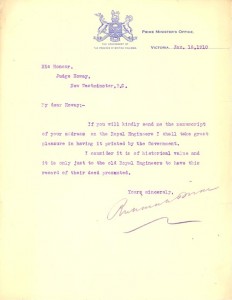
Letter from Richard McBride to Frederic Howay, Box 4 file 18 Frederic Howay fonds (click to see larger)
There are six letters from McBride to Howay (a judge, author, and collector of British Columbiana whose book collection is one of the founding collections at Rare Books and Special Collections). Among them is this letter in which McBride invites Howay to send his manuscript about the Royal Engineers for publication by the government. That manuscript presumably became this printed pamphlet.
Another method of searching will find items from our vertical file collection, which was featured in our post about Oliver. Vertical files are found in the library catalogue. By searching for items in Rare Books and Special Collections as the location and Richard McBride as your keywords, you will find a number of published items related to McBride such as speeches, and also this letter from Wilfred Laurier to McBride:
In it, Laurier refers to land transactions being made between First Nations groups and the government for the construction of the Grand Trunk Railroad.
Do these two search methods guarantee that you will find all archival documents related to Richard McBride? Unfortunately not. The nature of archival description is that it tends to describe groups of records, not individual items- if archivists catalogued every document individually, we would be hopelessly behind in our work! When using archives for your research, you sometimes have to think a little more creatively- who would have Richard McBride been corresponding with, and about what? This helps you choose appropriate keywords for your searches. For more resources on using archival material, check out our Archival Material research guide.
In the Barber Centre, the McBride Meeting room is room 265, which is one of the meeting rooms on the south side of the building, off of the Ike’s Cafe eating area.
No CommentsPosted in Collections, Research and learning, Uncategorized | Tagged with
Featured place: Bralorne
Posted on November 21, 2011 @9:37 am by kalsbeek
The Bralorne Reading Room (room 490 in the School of Library, Archival, and Information Studies, Irving K Barber Learning Centre) is named after the town of Bralorne, a gold mining community in the Bridge River District, 125 kilometers west of the town of Lillooet.
In 1897, three gold prospectors staked claims at what became the Bralorne Mining site: the Lorne, Marquis, and the Golden King claims. From 1897 to 1931, various people worked in the mines. Among those people was Arthur Noel, a prospector and his wife, Delina. Together, they owned and worked in the Lorne mine from 1916 to 1928, making $160,000 (Bralorne-Pioneer Museum)
In 1931, the mine was purchased by Bralco Development and Investment Company. Austin Cottrell Taylor, the owner of Bralco, renamed the mine Bralorne mine. From March 1932 to 1971, the mine, made up of the Bralorne, King and Pioneer mines, was “the largest historic gold producer in the Canadian Cordillera producing 4.1 million ounces of gold” (Bralorne Gold Mine Ltd.).

Image credit: Bralorne-Pioneer Gold Mine History (courtsey of Bralorne Pioneer Museum Flickr Photostream)
During the 39 years that the mine was in operation, a large town developed to support the hundreds of people who worked in the mine. There are a number of publications in the UBC Library collection on Bralorne (see, for example, Bridge River Gold), however, the Bralorne Pioneer Museum offers the best selection of resources. It was formed in 1977 with the mandate to preserve the history of the Bridge River Valley which consists of several small communities: Bralorne, Gold Bridge, Gun Creek, Gun Lake, Tyax Lake and Marshall Lake.
If you are unable to visit the museum in person, check out the Bralorne-Pioneer: Their Past Lives Here, a virtual exhibit that is part of the Virtual Museum of Canada website. Using photographs and stories, this virtual exhibit explores the history of Bralorne from the first discovery of gold in the Bridge River valley in the 1860s to the closing of the mine in the 1970s. The Virtualmuseum.ca website, a collaboration between Canadian museums and the Canadian Heritage Information Network (CHIN), includes 500 virtual exhibits promoting the content of Canadian museums and a gallery of 680,000 images drawn from Canadian museum collections.
Today, only a small number of people live in Bralorne. However, this may change, as the Bralorne Gold Mine was re-opened on May 27, 2011. Bralorne Gold Mines Ltd. is exploring and developing the between the historic Bralorne, King and Pioneer gold mines.
No CommentsPosted in Collections, Uncategorized | Tagged with
Happy birthday, Louis Daguerre!
Posted on November 18, 2011 @3:09 pm by sromkey
If you have been to Google today, it may have come to your attention that today is the 224th anniversary of the birth of Louis Daguerre, inventor of the first permanent photographic process, called a daguerreotype. Daguerreotypes were used from around 1839 to 1860, and differ in many ways from later photographic types: the process created a direct positive on a silvered copper plate. The result is a somewhat mirrored image, that because of its fragility, would have often been stored in a decorative case, behind a piece of glass. Because the image was transferred directly as a positive (meaning, there is no negative) it was not possible to make copies of the same image- every daguerreotype in existence is completely unique.
A search in our B.C. Historical Photograph Collection yields one lone example of a daguerreotype, a portrait of an unidentified man:
You can see that his rosy cheeks have been hand-painted on. Like many daguerreotypes, this one is in a decorative case:
For more daguerreotypes:
Library of Congress daguerreotype collection
Daguerreotypes at Harvard University
Search for daguerreotypes at Library and Archives Canada
See the process at the Getty Museum
and just for fun:
CBC wants you to send in your daguerreotype-style photos
My Daguerreotype Boyfriend (full disclosure- they aren’t all daguerreotypes)
For information on searching photograph collections at UBC, check out our Historical Photographs research guide.
No CommentsPosted in Collections, Research and learning, Uncategorized | Tagged with
Remembrance Day closure
Posted on November 9, 2011 @1:28 pm by sromkey
A reminder that except for UBC Okanagan Library, all other UBC Library branches, including Rare Books and Special Collections, University Archives and the Chung Collection will be closed for Remembrance Day on Friday November 11.
The photograph above, from the Chung Collection, shows the C.P.R. steamship the R.M.S. Empress of Russia leaving Vancouver when she was requisitioned by the British Admiralty. She, and many other C.P.R. ships, also participated in the First World War. Below is a photo of her ca. 1915 painted in “dazzle” camouflage, designed to confuse observers as to the type of ship, speed and direction.
The C.P.R. lost many employees, and ships, during both World Wars, which was written about recently on the Chung Collection News blog.
Details for UBC’s Remembrance Day ceremony can be found here.
No CommentsPosted in Announcements, Collections, Uncategorized | Tagged with
Chung exhibition room closure: Monday Nov. 7
Posted on November 3, 2011 @10:35 am by sromkey
The Chung Collection exhibition room will be closed to the public on Monday Nov. 7. Our apologies for this inconvenience.
Please note that this closure also effects the Rare Books and Special Collections Charles Van Sandwyck exhibition.
Cross posted with the Chung Collection news blog.
No CommentsPosted in Announcements, Chung, Exhibitions, Uncategorized | Tagged with Chung Collection
